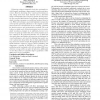Free Online Productivity Tools
i2Speak
i2Symbol
i2OCR
iTex2Img
iWeb2Print
iWeb2Shot
i2Type
iPdf2Split
iPdf2Merge
i2Bopomofo
i2Arabic
i2Style
i2Image
i2PDF
iLatex2Rtf
Sci2ools
IEEEPACT
2008
IEEE
2008
IEEE
Skewed redundancy
Technology scaling in integrated circuits has consistently provided dramatic performance improvements in modern microprocessors. However, increasing device counts and decreasing onchip voltage levels have made transient errors a first-order design constraint that can no longer be ignored. Several proposals have provided fault detection and tolerance through redundantly executing a program on an additional hardware thread or core. While such techniques can provide high fault coverage, they at best provide equivalent performance to the original execution and at worst incur a slowdown due to error checking, contention for shared resources, and synchronization overheads. This work achieves a similar goal of detecting transient errors by redundantly executing a program on an additional processor core, however it speeds up (rather than slows down) program execution compared to the unprotected baseline case. It makes the observation that a small number of instructions are detrimental to over...
Dramatic Performance Improvements | Hardware | IEEEPACT 2008 | Provide Equivalent Performance | Transient Errors |
Related Content
| Added | 31 May 2010 |
| Updated | 31 May 2010 |
| Type | Conference |
| Year | 2008 |
| Where | IEEEPACT |
| Authors | Gordon B. Bell, Mikko H. Lipasti |
Comments (0)

